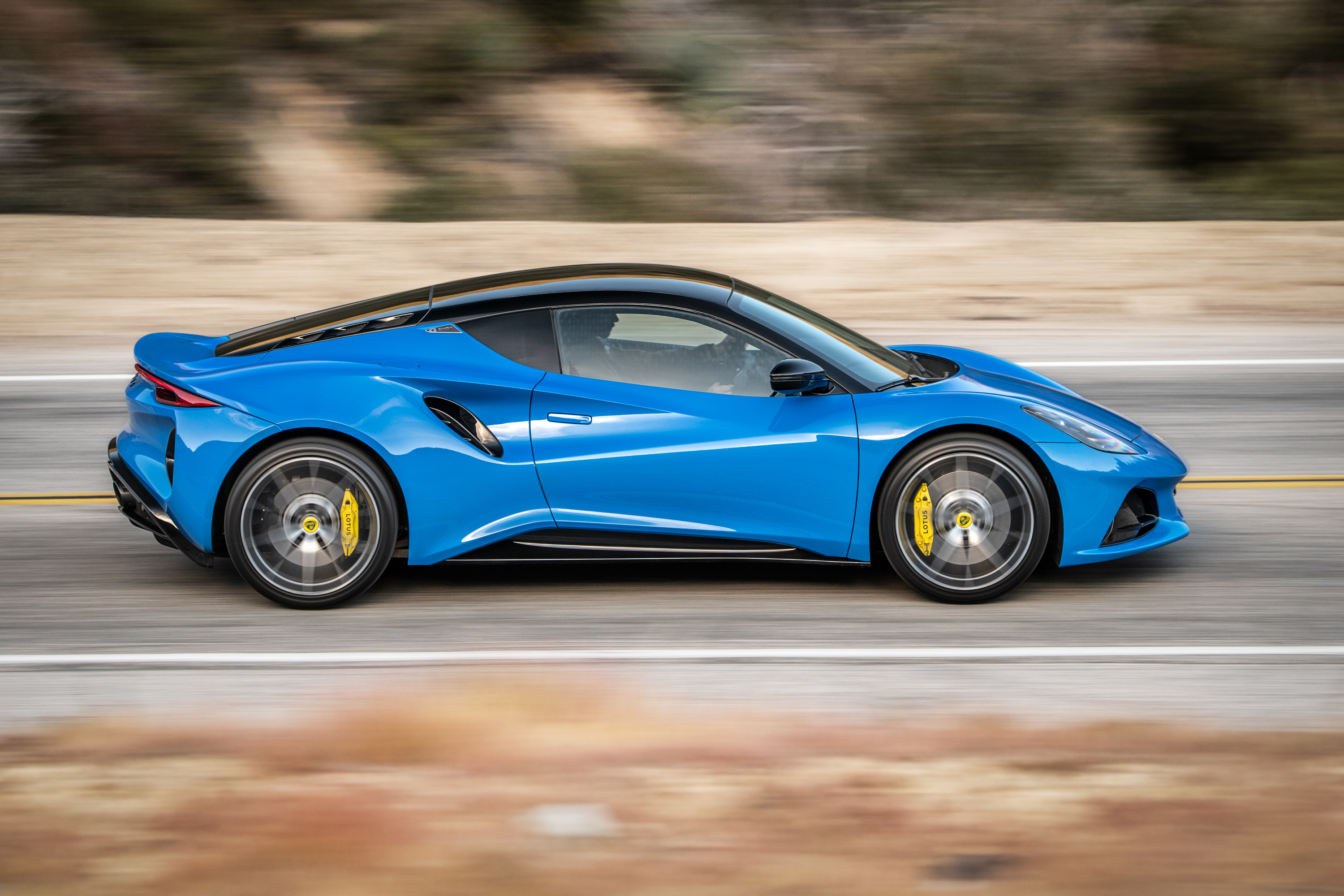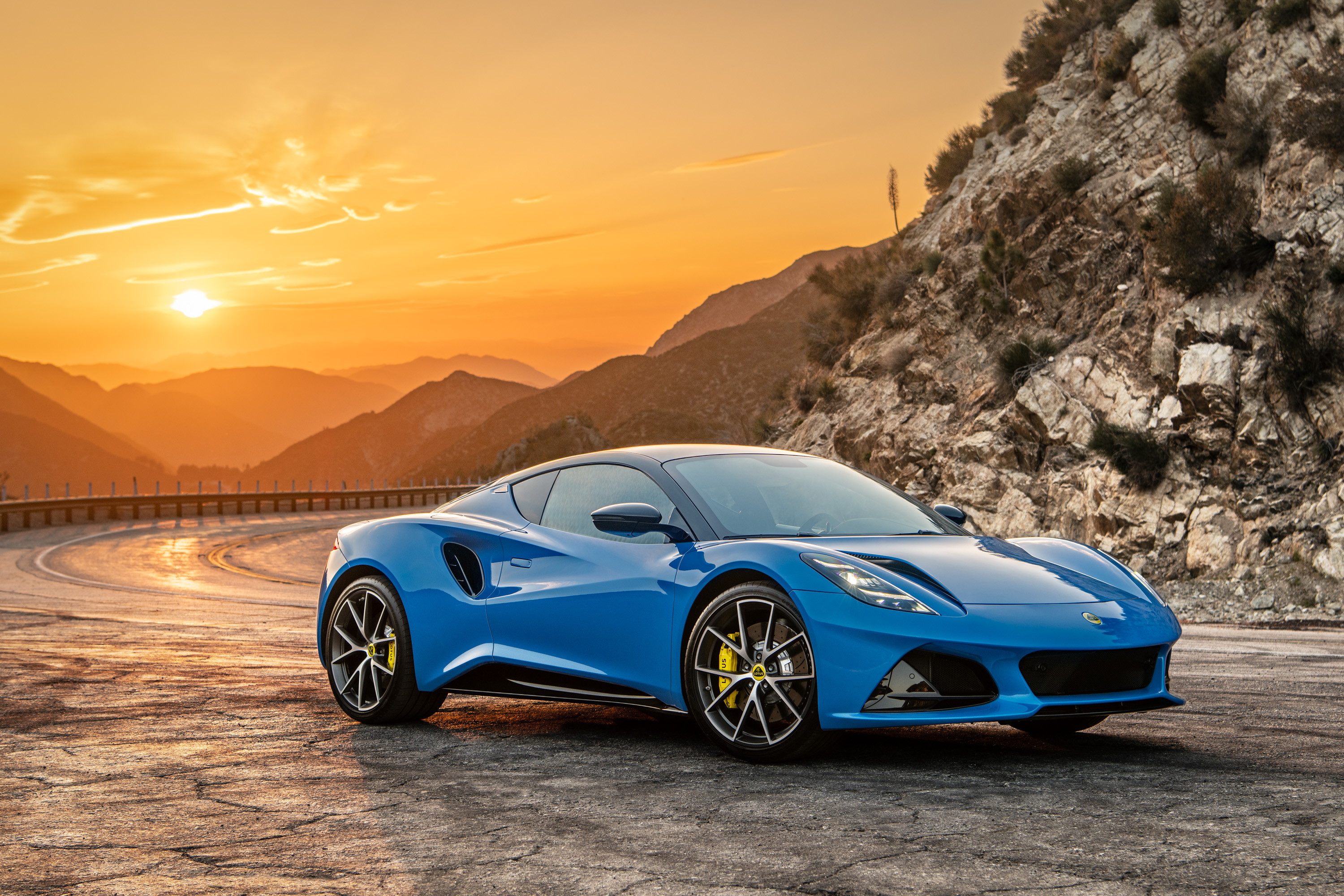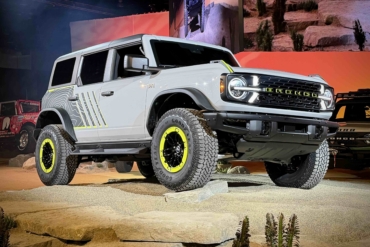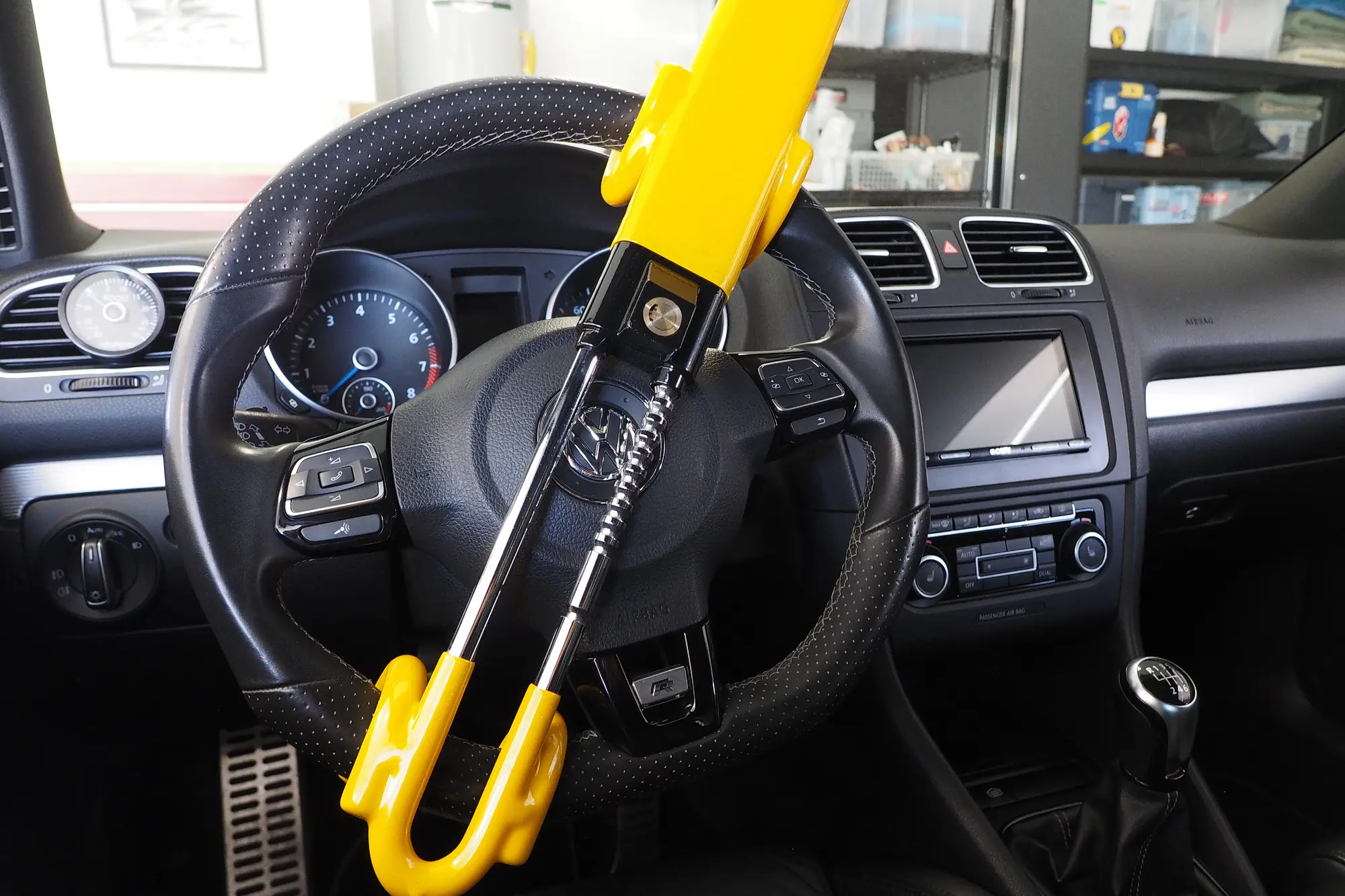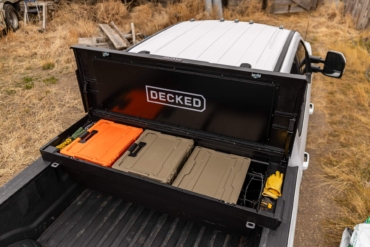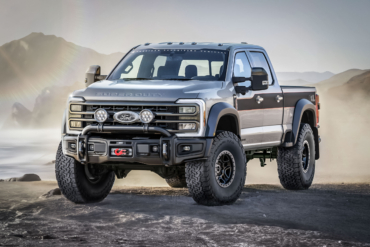Refined and Lotus aren’t words usually associated with each other. Lotus is about distilled lightweight and nimble performance cars that are just as much fun on backroads as they are on track — or that is at least what they’ve been historically. The Emira is mostly all those things, but also offers a refined interior.
I spent a bit over 300 miles in the hills around Los Angeles in the last of the gasoline-powered Lotus cars. I was specifically in the 2023 Lotus Emira Touring First Edition V6 manual. While I couldn’t get enough of this gorgeous sportscar in the canyons, I didn’t enjoy it as much in the many hours of heavy stop-and-go traffic I endured. The clutch is heavy in this car!
In short: The Emira generally sticks to the Lotus cars ethos, but it also brings interior and ride comfort refinement never before on offer from the British brand. That refinement does dull the lightweight and raw feel that Lotus is famous for, but just ever so slightly. The last gas-powered Lotus ever is a car likely to be coveted by enthusiasts for years to come.
- Engine: 3.5L supercharged V6
- Transmission: 6-speed manual
- Power: 400 hp, 310 lb.-ft. of torque
- Performance: 0-60 mph in 4.2 sec., 180 mph top speed
- Fuel economy (mpg): 16 city / 24 highway
- Curb weight: 3,212 lbs.
- Dimensions: 173.7” L x 74.6” W x 48.2” H; wheelbase: 101.4”
- MSRP: $105.400 starting price (in early 2024)
Pros
- Performance and comfortable ride dynamics
- Near-perfect steering feel
- Gorgeous styling
- Functional modern interior
- Impressive value price
Cons
- Seat is too high off the floor
- Shift from 2nd to 3rd is clunkier than it should be
- The exhaust note is lacking
- No good roof rack option
The Lotus Evora Successor
While Lotus says the new Emira is an all-new design, it has nearly identical dimensions, layout, and drivetrain to its predecessor, the Evora GT. Performance figures are nearly the same as well.
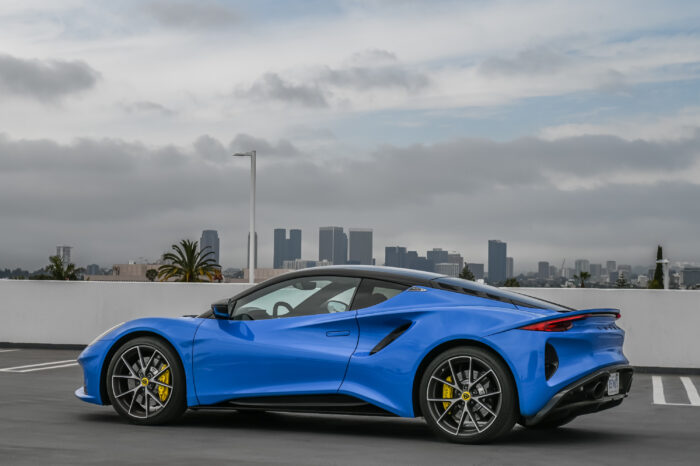
What the Emira does bring to the table is a more mainstream supercar swoopy body panel styling than the Evora GT’s sharp angular lines had to offer. It also offers a much-improved interior, complete with all the screens and gadgets that you expect in a modern car. Think of the Emira as a mature Evora GT.
The Evora hit the market all the way back in 2009 and stuck around until 2021. In 2017, Geely, a Chinese conglomerate, bought a controlling stake in Lotus and ushered the Emira to market, the last gas-powered Lotus ever. The first Emira, the First Edition cars, hit the U.S. market in late 2023.
Lotus Emira V6 Manual: Review
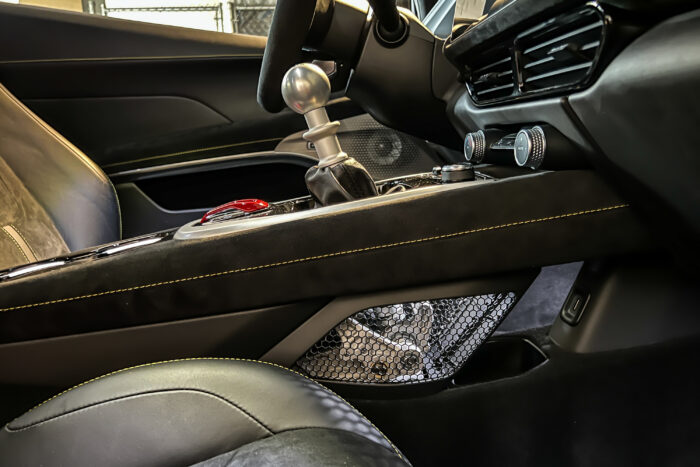
Feel From the Driver’s Seat
Emira’s stiff yet compliant chassis and hydraulic steering are properly world-class, as you’d expect from a Lotus. While the shifter is a bit clunky (the exact same as Evora GT, but didn’t feel as smooth to me), it is the perfect distance from the steering wheel and has a nice medium-distance throw to it.
You’ll have to deal with a bit of a heavy clutch pedal in the Emira, but it feels lighter than the Evora GT’s. Brake feel is very solid and progressive. The throttle pedal feels very responsive and smooth.
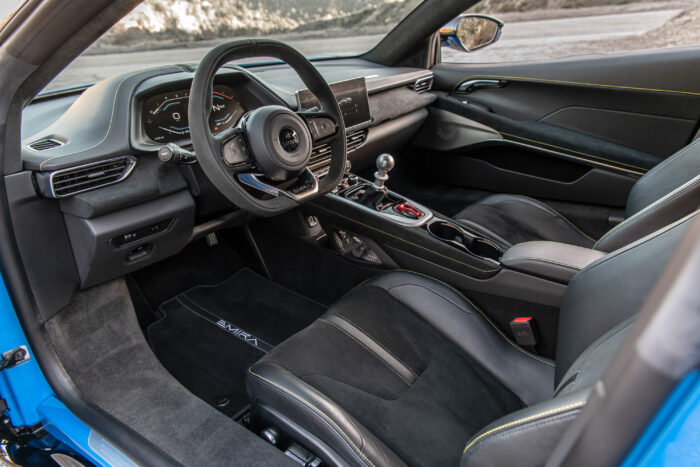
The door openings are larger and the sills narrower than the Evora GT. This does make getting in and out a much more graceful process, and easier for people like me with long legs, big feet, and a bad back.
A nearly perfectly shaped and sized steering wheel makes you feel connected to the car. The wheel does look a bit odd in its proportions, but feels good in the hands and provides great visibility to the digital gauge cluster.
As I settled into the stiff and supportive seats, it was easy to adjust them to fit me nearly perfectly. I did find the lowest position of the seat to be too high off the floor for my liking, however. With that said, even my tall frame — 6’3″ and mostly torso — had plenty of headroom, enough so that I don’t think wearing a helmet for track days would be an issue at all. The lumbar adjustment is a nice addition, but the seats are hot and could use ventilation — I’m sure they don’t because that would add too much weight.
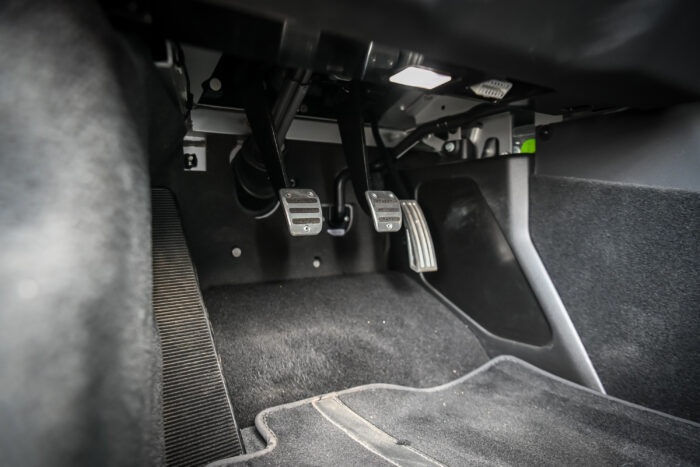
The pedal box is plenty big for my size 13 feet, but the pedals are relatively close together and narrow driving shoes are a good idea. The clutch pedal is a little closer to the driver than the brake pedal, which does make it kind of hard to left-foot brake — if you’re into that sort of thing — smoothly and consistently without some practice.
Emira Cabin Appointments
The black Alcantara with yellow stitch interior feels sporty and premium. But, the brushed aluminum trim around the shifter seems out of place. This is because all the other trim inside the car, like on the steering wheel, along the doors, and the outer air vents, are all bright, shiny silver and not brushed. The shiny black plastics in the car always look dirty and smudged as well, which is annoying.
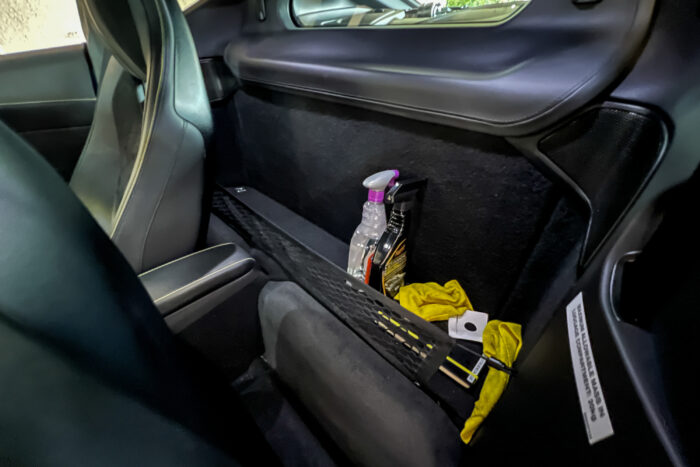
While back seats were available on some Evora models, they are not available on an Emira. Instead, you get a small parcel shelf with netting to hold cargo in place. You’ll want to secure anything you put back there quite well, as you’ll no doubt want to hurl this car around corners quickly.
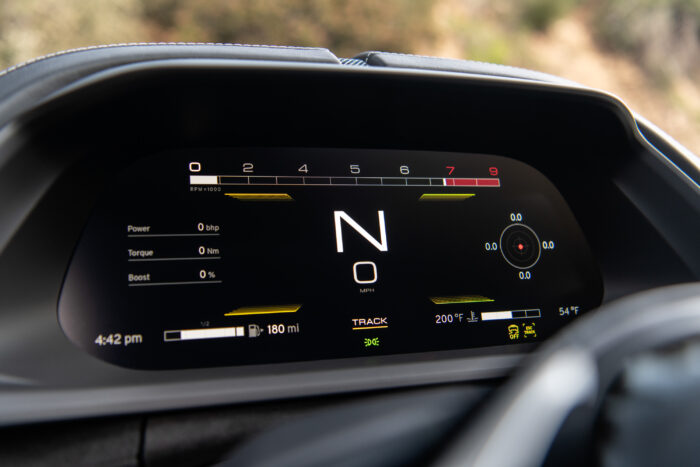
The Emira has bright modern digital screens — a first for a Lotus —and kind of feel out of place. They are both quite simple and clean, and they work well.

Other modern niceties like wireless Apple CarPlay and Android Auto, automatic headlights, automatic wipers, infotainment system voice control, and a large central touchscreen are also all standard on the Emira. These features aren’t what you might traditionally expect in a Lotus sportscar.
The Emira has the right amount of hard buttons and the steering wheel buttons are very versatile. I like the drive mode and stereo buttons in the center stack as well. Basic HVAC controls outside of the infotainment system are also a welcome feature on a modern car.
If you’re searching for the parking brake, like I did, you’ll find the electronic switch for it to the left of the steering wheel on the dash.
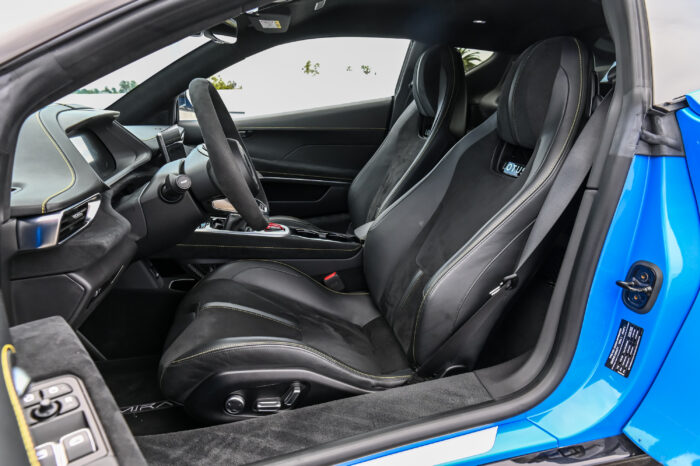
While the sound system in the Emira is quite nice, I don’t know why you’d buy this car to listen to music. The engine is always a presence in the cabin. It almost sounds like you have an open window in the back cracked just a little bit and you can hear the air rushing in. But, it’s really just the supercharger loudly ingesting massive volumes of air right behind your head.
Sadly, the exhaust on the Emira doesn’t sound nearly as good as the intake noises. The exhaust note is not as good as the Evora GT because of its routing in the car — that is the best guess I or any U.S. Lotus reps can figure out. However, I imagine the aftermarket will sort this out in short order.
I was super impressed that with one or both of the windows down, there was little to no wind buffeting in the cabin at any speed. That is rare among sportscars, and something that is an issue in modern cars like the Toyota Supra.
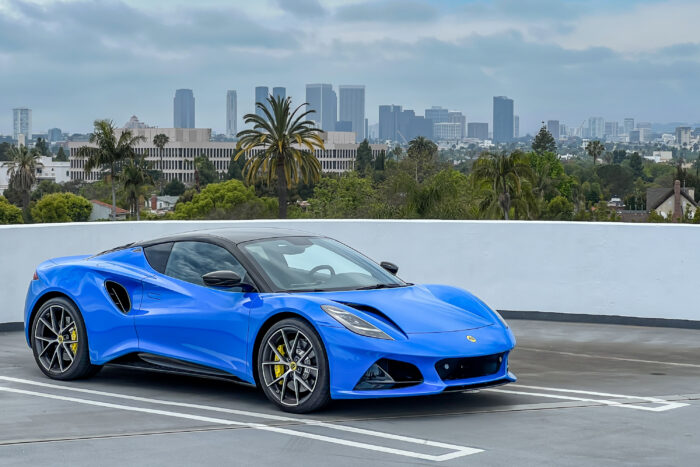
Lotus Emira Design
Overall, I think that Emira is a supremely gorgeous car all around. The proportions just work. Sure, non-car people might mistake it for a McLaren, but I’m not sure that is all that bad a thing.
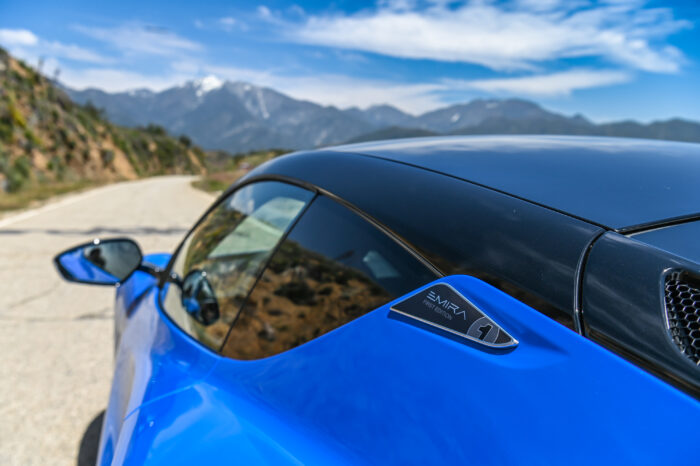
The beltline drops down to gorgeous side mirrors. The mirrors offer much-needed visibility, as there is a substantial blind spot in the rear three-quarters of the car.
While I generally prefer my Lotus in deep shades of green or metallic grays, the Seneca Blue on my test car was beautiful. The paint itself was deep and sparkled in the SoCal sun. It also attracted a lot of attention, which might not be the best if you’re trying to go unnoticed by law enforcement.
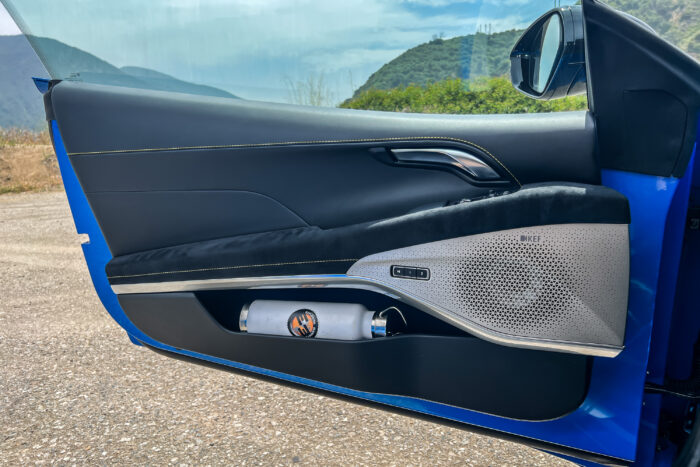
The exterior door handles on the Emira are kinda cool, but also very annoying. They are very hard to open with one hand, which makes getting into the car with anything in your hands near impossible. The inside door latches, to get out of the car, are just as bad.
One oversight by the Lotus Emira designers is the rear hatch ergonomics. There is no handle or way to close the hatch/trunk/engine-cover, besides pushing on the exterior of the trunk lid, which adds fingerprints to the paint.
Like all Lotus for the past 30ish years or so, there aren’t any real roof rack options for it. I asked Lotus about roof rack options, and their response was that “there are no current plans for a roof rack option and third-party suction cup racks will be the most viable option.” Sure, you can put a SeaSucker suction cup style rack on it, but even that I’d be wary of at speed, as the roof panel is thin — to keep weight low.
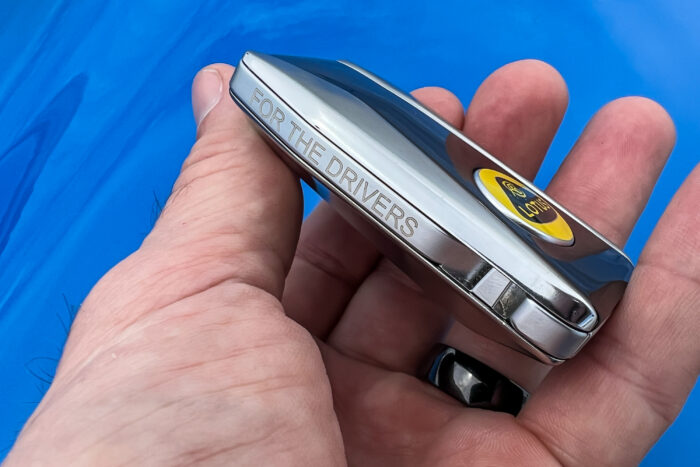
While the key is very Volvo parts bin, it does have a nice touch. On both sides, it reads “For The Drivers.” Sadly, however, it is not a proximity key, meaning you must press the unlock button to get into the car.
Power & Weight
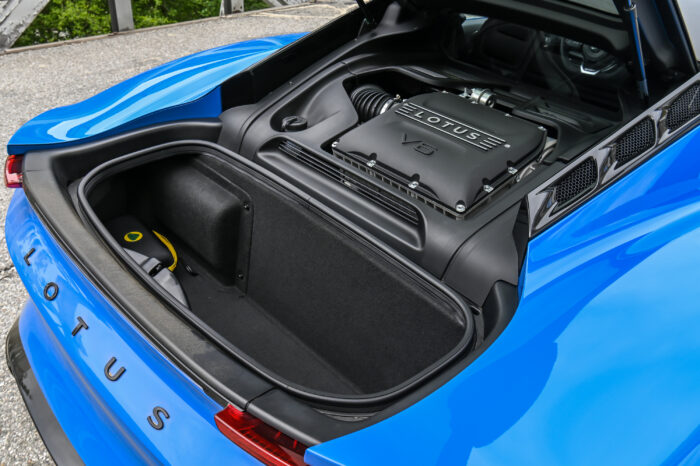
The supercharged 3.5L V6 — the same basic motor you’d find in a Toyota Camry — puts out appropriate levels of power (400 horsepower, 310 pound-feet of torque) to have all kinds of fun. Mounted mid-ship, it helps with the car’s balance (62% rear/38% front — very similar to a Porsche 911) and helps it keep the weight down (3,212-pound curb weight).
The Emira is a few hundred pounds heavier than the Porsche Cayman, its main competitor. It’s similarly heavier than the Evora GT it’s replacing, which isn’t surprising given all the added tech and creature comforts.
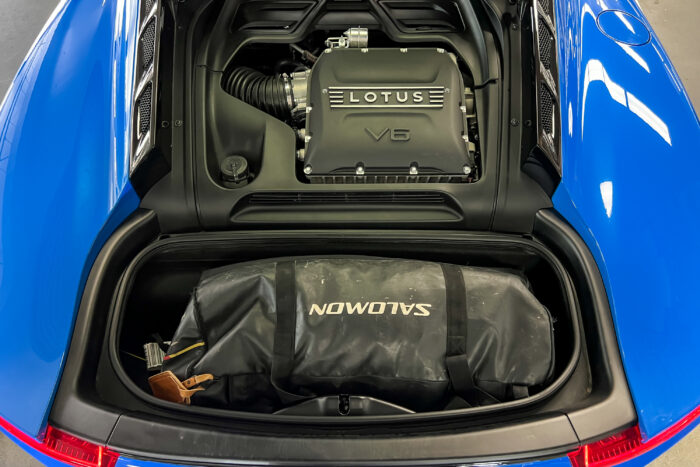
The max payload of the Emira is only 595 pounds — excluding fuel and fluids. The rear trunk is only rated at about 110 pounds while the rear parcel shelf is only rated at 44 pounds. That’s not a lot of luggage or groceries, especially if you have a passenger. Also, you won’t want to put groceries or electronics in the trunk, as it gets way too hot back there — as it’s essentially in the engine bay. There is no frunk on the Emira.
One thing to note: the big 20-inch front wheels visibly vibrate when the Emira is parked idling. It has a much rougher idle than you’d expect from such a car, especially with basically a Camry motor.
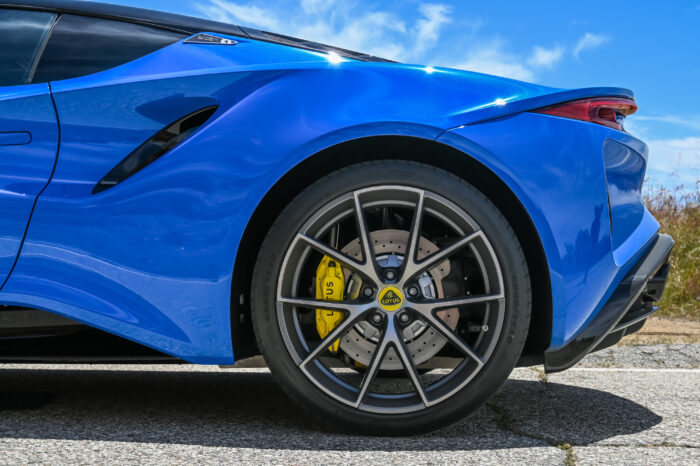
Driving Modes
The Emira has three drive modes: Tour, Sport, and Track. There is no custom drive mode option. The drive modes only change the throttle map, exhaust, and nannies (stability and traction control).
There is no dedicated exhaust button or control. And, you only get full “loud” exhaust in the Track driving mode.
I drove it in Track mode most of the time to get the most out of the exhaust. I found it to work well in all conditions, as steering and suspension aren’t changed — like they are on many other cars with drive modes.

Emira: Touring vs. Sport Models
When considering an Emira, there are few options you have to consider, but there is one big one: Touring versus Sport. The Touring chassis vehicles are fitted with less aggressive spring and damper rates, and they are fitted with Goodyear Eagle F1 Super Sport tires. Sport Chassis Emira are fitted with more aggressive springs and damper rates and feature Michelin Pilot Sport Cup 2 tires.
In my view, unless you’re planning to spend lots of time on track, the Emira Touring is the right option. The tires alone are more playful and fun, versus a complete focus on optimal cornering Gs that the PSC2 tires provide. Also, the Touring suspension setup is amazingly composted over rough roads.

Emira: Manual vs. Automatic
Yes, you can buy the Lotus Emira with a V6 and automatic and with a four-cylinder turbo and DCT automatic. But, why would you? A Lotus is traditionally a driver’s car — maybe changing with modern EV offerings — and in my opinion, should be shifted with a stick and the use of a clutch pedal. The Emira is likely the last manual Lotus ever to be offered, so enjoy shifting your own gears while you can.
Sitting in traffic kinda sucks in this car, however, with its heavy clutch pedal. So, maybe flappy paddles are the way to go if you live in places like L.A. But, if you want the limited-slip differential — which you probably do — then the V6 manual is the only version to buy.
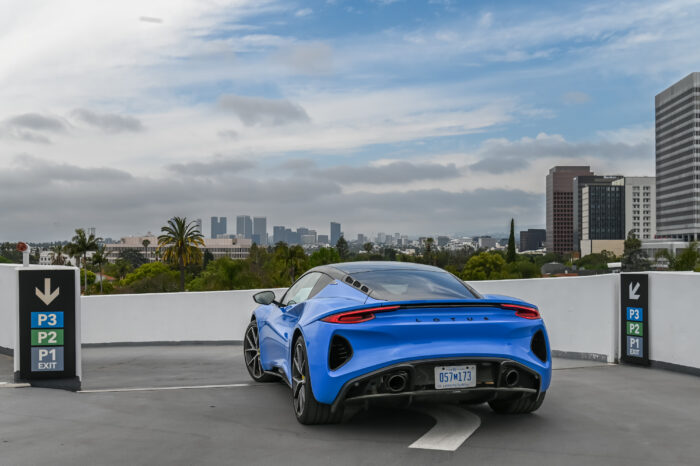
Lotus Emira Review: Conclusions
One possible downfall to buying an Emira in North America is the tiny dealer network. Another is the question mark as to how many parts are going to be available in the future from this small Chinese-owned, British sports car company that is currently switching to all-electric — and offering SUVs. Luckily, motor-wise, there are lots of Toyota parts out there to keep them running.
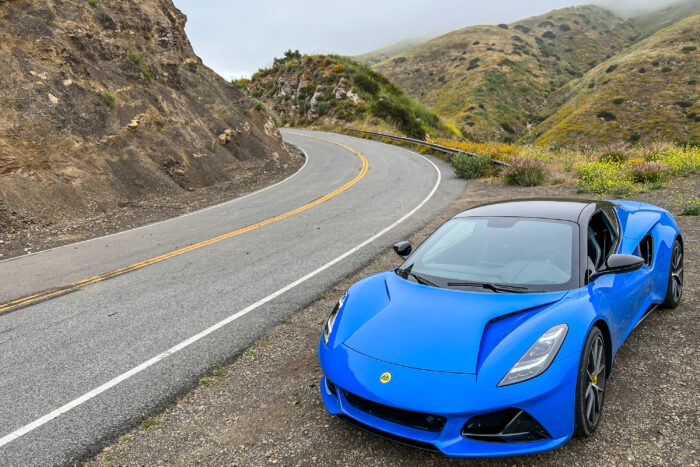
While pricing has gone up about $9,000 since first announced to when first delivered on U.S. soil, the Lotus Emira still offers an impressive sporstcar value. The starting price for the Lotus Emira is $105,400.
If you want raw speed and power, especially in a straight line, the Emira is not the car for you. There are lots of better options on the market. But, if you want a car that feels extremely nimble, gives you all the right feedback from the road, and is extremely fast in the corners, the Emira is one of the very few new car options that will satisfy.
You can find your local Lotus dealer and configure your own Emira.
Evora GT or Emira for Me?

The Emira is a better car in nearly every way than the Evora GT it replaces and will satisfy 99% of buyers more. I, however, would buy an Evora GT instead.
Yes, it probably isn’t built as well, doesn’t have the modern infotainment features, and is harder to get in and out of. The Evora GT is, however, a sharper machine that provides a more satisfying exhaust note and crisper shifts, is a bit lighter, and has a seating position that I prefer for performance driving.
As they say, different strokes for different folks.
